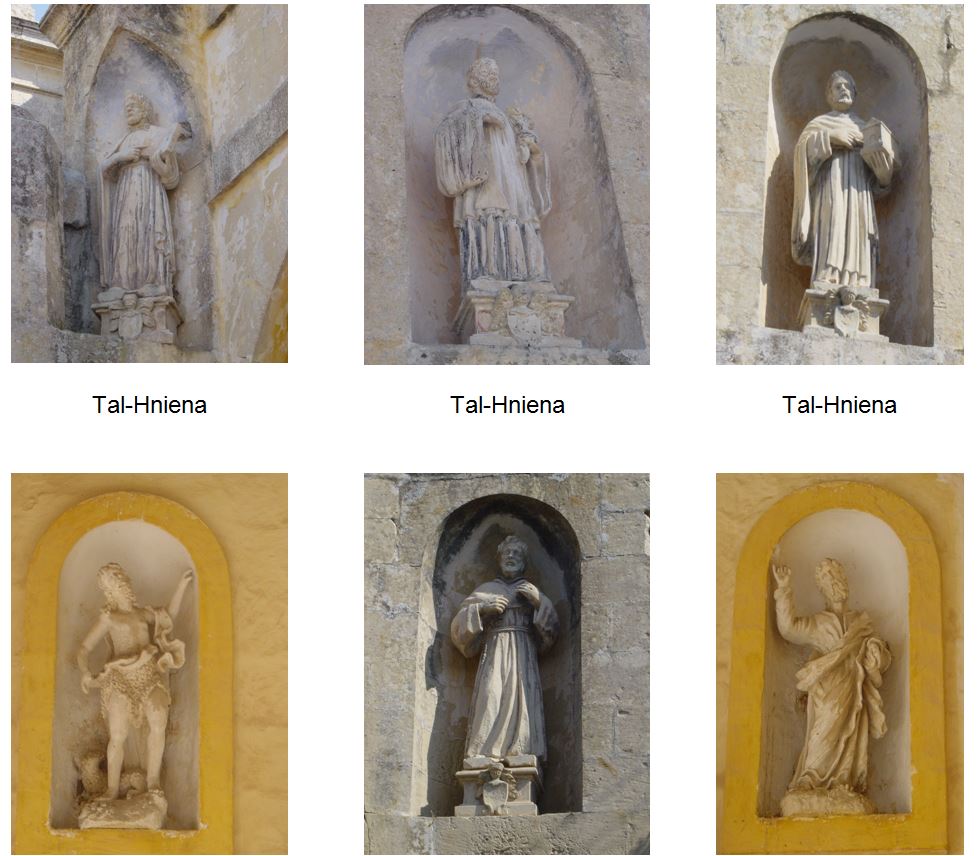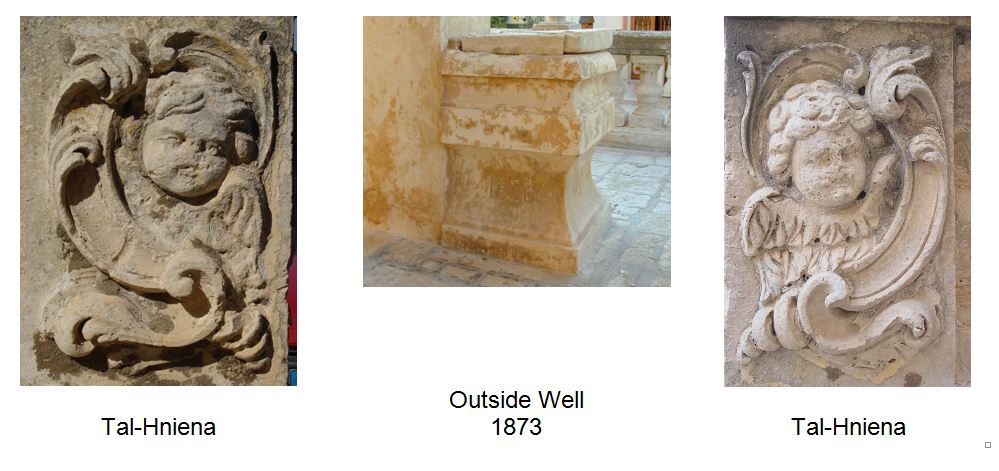
The Madonna tal-Hniena chapel (Our Lady of Ransom) has long been held in great veneration. It has been built in the thirteenth century when the hamlet of Hal Lew still formed part of Zurrieq. When Zurrieq became a parish, the tal-Hniena chapel served as a vice-parish church caring for the spiritual needs of the people from this outlying area.
In 1575, the tal-Hniena was in a bad state, and was deconsecrated by Mgr. Dusina. In spite of this measure, the devotion of the faithful continued unabated and the chapel was rebuilt in the year 1650 at the time when Dun Gammari Camilleri was parish priest of Qrendi.
The new parish of Qrendi had been formed on the 15th February 1618, when Bishop Cagliares dismembered the hamlets of Hal Lew and Hal Manin from the parish of Zurrieq.
The chapel often referred to as Chiesa Della Misericordia, has three altars from which a spiral staircase, at the side of the right hand side altar, leads onto the roof. Above the entrance to this place of worship one can find a wooden choral gallery accessible by only by ladder through a trap door at its side.
In 1668, a simply but interesting small sacristy with a barrel vaulted ceiling was added in which one can witness numerous decorative stone carvings. Above the sacristy’s window is a highly impressive stone prospect of Almighty God that trails a decorative carved braid where the Bailiff of Brandenburg, Fra Wolfgang von Guttenberg’s coat of arms, features prominently.
A marble Scallop Shell shaped Holy Water font, (A symbol of Christianity), bearing the date 1769, also features the same coat of arms. At one of the sacristies corners, a small cistern supplies water beneath to a basin, supported by a stone angel statue, providing continuously running water used during religious services.

The Main Altar is decorated with a highly detailed stone carved prospect featuring numerous angel figures amongst which, two support the titular painting whilst another two carry a crown to be placed on the Madonna’s head.

The titular painting is that of the Madonna and Child seated on the moon surrounded by angles. Saint Gaetano, book in hand and lilies at his feet liesat her lower right and two souls at her lower left. The work is attributed to a well-known Maltese artist, Guzeppi D’Arena. To the left of the main altar, a candelabra sculpted in wood is identical to that found at the St. John’s Co cathedral in Valletta.
A small wooden niche with a life-sized statue of the Madonna lies to the right of the main altar. The Spanish style statue of the Madonna was donated by Fra Wolfgang von Guttenberg and is dressed in an authentic wedding gown.


On the same side of chapel hangs the painting of Saint Anthony of Padova, attributed to Rokku Buhagiar, symbolizing the saint’s great devotion. From Bishop Alpheran de Bussan’s visit we learn that St Anthony’s feast day was celebrated yearly at the tal-Hniena chapel.
The old statue of the Christ the Redeemer (Ir-Redentur) that rests beneath this painting was originally brought from one of Cottonera churches. The “Redentur” statue is carried, in religious procession to Qrendi, during the Good Friday celebrations.


One can hardly but notices a Confession box that dates back to the eighteenth century, finely sculpted and decorated in the styles of the times
In another painting in the chapel appear three figures thought to be St. Ramon de Penafort, St Peter Nolasco and Jaime Primero “el conquistador”, king of Aragon (1263 – 1276) who had formed the congregation “De mercede redemptionis captivorum” (the ransom of captives”.


Within the Madonna tal-Hniena chapel, evidence of the devotions of this place of worship is evident through the numerous “Ex-voto” paintings that hang on its walls. “Thanks giving” (ex-voto) paintings for the cure of illnesses, being spared from the 1676 plague and numerous shipwreck savings, adorn the walls. Balliju Guttenberg commissioned other ex-votos.
Near the main door an interesting paintings represents the fourteen “saint protectors” who were invoked by Maltese in cases of sickness and other trials. These are: St. Blaise (throat disease), St. George (diseases of the skin), St. Erasmus (bowels), St. Pantaleon (tuberculosis), St. Vitus (Dance and poisonous bites), St. Christopher (travel, storms), St. Dionisius (possession by the evil spirits), St. Ciriacus (eye diseases), St. Acacias (diseases of the head), St. Euchachius (burns), St. Giles (lunacy and the evil eye), St. Margaret (kidney and childbirth), St. Barbara (lightning and sudden death), St. Catherine (the study of philosophy).


A truly and unique painting is that which portraits Mortal Sins and shows an ass laden with side baskets “full” of nasty sinful habits, or as is locally known, “Is-seba rjus tad-dnubiet il-mejta A blindfolded and chained sinners is beaten on this hands and knees and is led away from Holy Grounds by a winged Satan
Another interesting painting is showing Christ’s crucifixion on the Golgota and attributed to Suor Maria De Dominicis, from the school of Mattia Preti. Fra Guttenberg donated il-Wooden cross in front of the painting.

On the left side of the isle one can see a stone statue of the Madonna and her Child, a statue that replaced an older statue carved in wood that was originally inaugurated in 1658. Outside the Tal-Hniena Sanctuary one can find parquet with a stone arched veranda that served as a place of shelter against the elements to those traveling from afar coming to worship at this place of prayer. A well was dug beneath the verandah in 1873 Surrounding the parquet, a line of balustrades feature stone sculpted Christianity representations Within the verandah and on the outside of the stone arches are niches with statues of Saint Ignatius, Saint Gaetan, Saint Dominick and Saint Francis, whilst at the side of the main door one finds Saint Paul and Saint John the Baptist



On the 18th March 1695, at the request of Parish Priest Dun Dumink Formosa, Pope Innocent XII granted indulgences in favour of Tal-Hniena. This parish Priest’s zeal was the cause of his death as when in 1699 the new Qrendi parish church was being built, setting an example to the parishioners, he climbed a tall ladder carrying a heavy stone, fell and was instantly killed. A number of bishops visited this sanctuary amongst who, on 3 May 1679 was Bishop Molina refereed to the chapel as “Sidtna Marija tal-Grazzji”, Our Lady of Graces. Bishp Alpheran de Bussan visited Tal-Hniena in 1745, where he was welcomed by Dun Gorg Hellul.at his start of a pastoral visit to the Qrendi Parish


